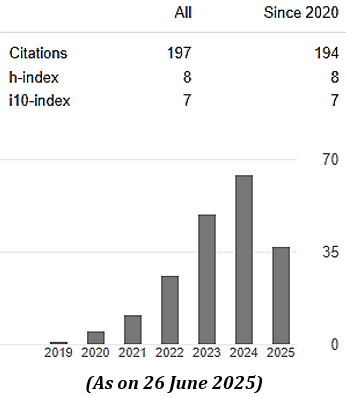Comparing the Potentiality of Propane, Propanol and Octane Fuel Using in SI Engine Based on Energy-Exergy Analysis
DOI:
https://doi.org/10.47981/j.mijst.09(01)2021.244(45-53)Keywords:
Potentiality, Energy, Irreversibility, Exergy, Combustion, Friction, EfficiencyAbstract
From the beginning of IC engine era, it is trying to improve the performance and efficiency of internal combustion engine. In this study, numerically analysis on combustion of Propane, Propanol and Octane in SI engine have been done thoroughly and presented to assess the potentiality and highlighted the comparison. For this analysis thermodynamic engine cycle model is developed for numerical analysis. Mathematical models considering fundamental equation and empirical relation are implemented in a single cylinder 4 stroke spark ignition engine (system) with the help of FORTRAN 95 to find out heat losses, friction losses, output parameter etc. Single cylinder four-stroke spark-ignition (SI) engine is considered as system. In this study, different working parameters like 8 and 12 compression ratios with three different rpm 2000, 4000 & 6000 are considered for simulation. This study shows the different comparisons of energy-exergy content (%), as example of exhaust gas 35.08 & 17.82, 37.02 & 19.22, 37.79 & 19.79 for Octane (at compression ratio 8 and 2000, 4000, 6000 rpm) etc., which explains the potentiality content and the potentiality losses in different process like combustion, mixing of gases etc. It also shows for the fuel propane and propanol in similar way with changing different operating conditions. Maximum inside cylinder temperature, 1st law and 2nd law efficiencies were determined for the fuels with respect to different compression ratio and engine speed.
Downloads
References
Ferguson, C. R., & Kirkpatrick, A. T. (2001). Internal Combustion Engines: Applied Thermosciences. John Wiley & Sons.
Heywood, J. B. (1988). Internal Combustion Engine Fundamentals. McGraw-Hill.
Moran, M. J., & Shapiro, H. N. (2000). Fundamentals of Engineering Thermodynamics. John Wiley & Sons, New York.Bishop I. N. (1964). Effect of Design Variables on Friction and Economy. Society of Automotive Engineering (SAE), 334-379.
Eduardo, A. M., & Fernando, A. (2017). Thermodynamic Properties of Propanol and Butanol as Oxygenate Additives to Biofuels. InTech Journal, 363-389.
Hakan, Ö., & Abdülvahap, Ç. (2018). Comparative exergy analysis of oxygenated fuel additives in a spark-ignition (SI) engine. International Journal of Automotive Engineering and Technologies, 7(3), 124-133.
Juan, E. T., José, I. H., Sebastián, O., Luis, F. Q., & José, E. N. (2018). The Effect of using Ethanol-Gasoline Blends on the Mechanical, Energy and Environmental Performance of In-Use Vehicles. Energies, 11, 1-17.
Kumar, D., Singh, A., & Sarma, A. K. (2015). Energy and Exergy Analysis of CI Engine for Karanja Biodiesel. International Conference on Advances in Energy Research (ICAER).
Kuntesh, M., Ashish, J. M., & Dipak, G. (2017). Energy and Exergy Analysis on Si Engine by Blend of Ethanol with Petrol. International Journal of Advanced Engineering Research and Science, 4 (4), 49 - 61.
Mizanuzzaman, M. (2012). Effect of bore stroke ratios on overall friction model of SI engine. MIST Journal of Science and Technology, 1, 71-86.
Mizanuzzaman, M. (2013). Advantages of roller follower for different bore stroke ratios and effects on overall friction of SI engine. MIST Journal of Science and Technology, 2, 8-17.
Mizanuzzaman, M. (2017). Energy and Exergy Based Analysis of SI Engines Using Methane, Methanol and Octane. MIST Journal of Science and Technology, 5, 102-111.
Mizanuzzaman, M. (2018). Thermodynamic Analysis of Spark Ignition Engine Using Ethane, Ethanol and Octane. BUP Journal, 6, 99-111.
Rakopoulos, C. D. (1993). Evaluation of a spark ignition engine cycle using first and second law analysis techniques. Energy Conversion and Management, 34(12), 1299-1314.
Rakopoulos, C. D. & Giakoumis, E. G. (2006). Second law analyses applied to internal combustion engines operation. Progress in Energy and Combustion science, 32, 2-47.
Sezer, I., Altin, I., & Bilgin, A. (2009). Exergetic analysis of using oxygenated fuels in spark-ignition (SI) engines. Energy & Fuels, 23(4), 1801-1807.
Sezer, I., Altin, I., & Bilgin, A. (2008). Exergy analysis of SI engines. International Journal of Exergy (IJEX), 5(2), 204-217.
Shirazi, S. A., Foust, T. D., & Reardon, K. F. (2020). Identification of Promising Alternative Mono-Alcohol Fuel Blend Components for Spark Ignition Engines. Energies,13, 1-16.
Simeon, I., & Kiril, H. (2012). Analysis of Engine Speed Effects on the Four Stroke GDI Engine Performance. Proceeding in Manufacturing System, 7(4), 229-234.
Haq, M. Z., & Morshed, A. (2013, July 29 - August 1). Energy and Exergy based analyses of a multy-fuelled SI engine. Proceedings of the ASME 2013 Power Conference, Boston, Massachusetts, USA. (Paper No. Power 2013-98279, ASME).
Downloads
Published
Issue
Section
License
Copyright (c) 2021 MIST INTERNATIONAL JOURNAL OF SCIENCE AND TECHNOLOGY

This work is licensed under a Creative Commons Attribution-NonCommercial 4.0 International License.
MIJST follows the open access policy.

This work is licensed under a Creative Commons Attribution-NonCommercial 4.0 International License. This allows anyone to copy, share, distribute, and modify the work for non-commercial purposes, where the original work and source should be properly credited.
















